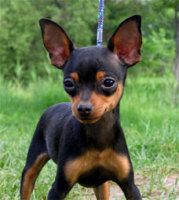The Russian Toy is one of the slightest of all the dog breeds, but it relies on its wits and a charming, larger-than-life personality. A dog that’s neither overly stubborn, nor overly curious and with modest grooming needs, this breed has traditionally been underappreciated as a pet breed, but that’s been changing over the years. Take a serious look at this toy breed, and think about making one of these dogs your next travel companion.

…HAVE EVERYTHING?
Size and Travel Options
Standing between 8-11 inches tall and weighing between 3.5-6.5 pounds, the Russian Toy Terrier should have little trouble qualifying for cabin travel with most airlines. Owners might think about putting shorter Russian Toy dogs in a hard-sided carrier because of their fine bones and structure, but we still generally recommend a soft-sided carrier for the extra space. Taller members of this breed will definitely need the extra space.
That said, we suggest being extra mindful of harried and careless passengers when making your own way through the airport. Especially since this breed is NOT hypoallergenic. We offer similar advice for traveling on trains, subways, automobiles and other forms of transportation. The Russian Toy should have few issues tagging along for the ride as long as it has a safe space.
Personality as a Travel Companion
The Russian Toy is known for having a middling personality for sociability and gregariousness. The breed is eager to please and to be affectionate with its owner, but can sometimes be aloof with new people. This can be a plus for travelers who are wary of a dog that’s always barking or hiding, but also doesn’t want a dog with too much of a prey drive.
This smart, lively, and eager-to-please breed is also a good one for learning and performing tricks. A medium-energy dog, its curiosity may not be off the charts, but it is demanding of affection. If neglected for too long, they’ll find a way to let you know by acting out in one way or another. The Russian Toy can be a great travel companion, but business travelers who are stuck in meetings all day may want to have a plan for doggy daycare.
There are two types of Russian Toy dogs based on the coat of fur. The long-haired variety is especially pronounced at the ears and will need brushing at least twice a week. The short-haired variety can get by with weekly brushing and is known for having a slightly more outgoing personality like a terrier than the long-haired variety.
Health and Longevity
These are generally very healthy breeds, but they do share health concerns common to most toy-sized breeds including patellar luxation, eye disorders, and dental/periodontal disease. Most health conditions can be screened for at the time of adoption. Due to their fragile necks, only harness leashes should be used. Despite their diminutive frame, they enjoy a long life expectancy of 12-15 years.
Russian Toy Breeders and Adoption Centers
While this dog breed still isn’t especially common, it’s gradually become more so over the decades. The breed was almost entirely wiped out when the Russian Revolution prohibited dog breeding for companionship. Before that, the Russian Toy had been a favorite of the Russian aristocracy and was originally bred from the English Toy Terrier that arrived in Russia during the 1700s. The limited lineage also gave rise to the long-haired Russian Toy from a single litter in the 1950s.
Today, you can sometimes find the odd Russian Toy mix at adoption and rescue centers, but for a healthy Russian Toy puppy, it may be necessary to contact a reputable breeder. These dogs can cost between $300-$800 from an adoption center, pet store, or neighborhood litter. No more expensive than other toy breeds, a puppy with a strong pedigree from a reputable breeder may cost between $800-$3,000.